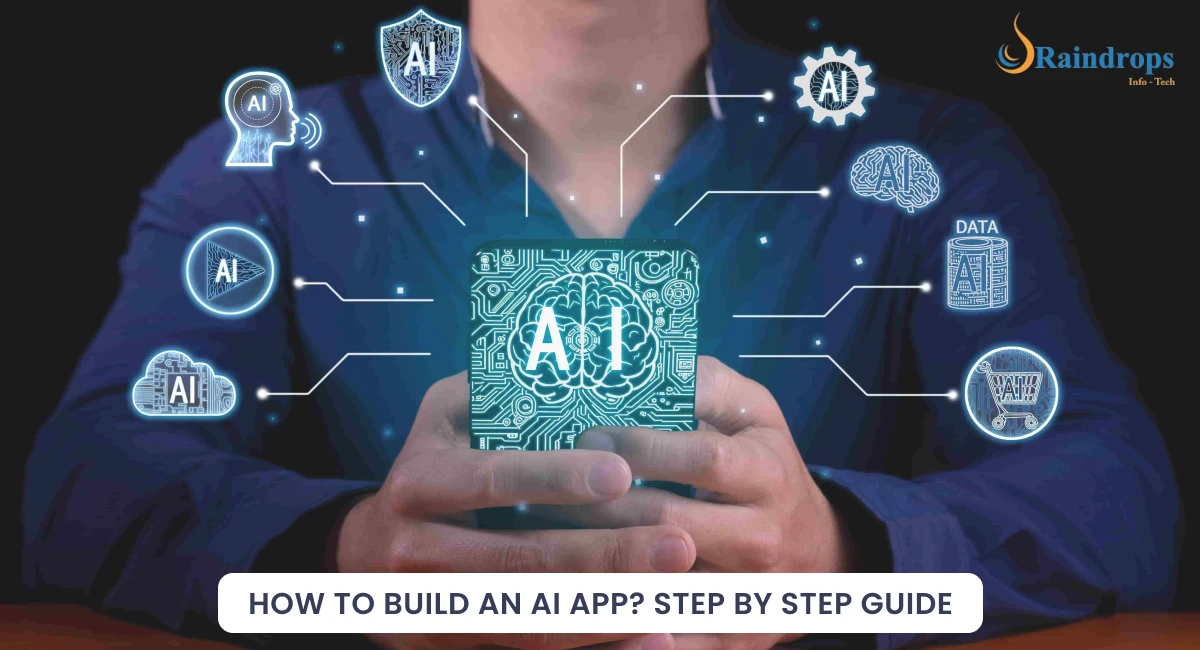Step-by-Step Guide to create an AI app
Imagine having an app that doesn’t just work but thinks! Sounds fascinating? That’s Artificial Intelligence (AI) in work. It is truly changing the way we interact with technology, and app development is no exception. From virtual assistants to personalised recommendations, AI enhances user experience and increases efficiency. And, in today’s competitive world you need to do things that let your business stay ahead. Whether you’re an entrepreneur, developer, or business owner, going for AI app development can set you apart.
In this ultimate guide, you’ll learn everything you need to know to develop an AI app that stands out in the competitive market. Ready to bring your AI powered app idea to life? Let’s get started!

Why use AI for your app?
Let me tell you, AI is more than just a trend. It’s taking up people’s jobs, and you still doubt its importance? More than a tool, it’s your biggest weapon! If used in the correct way, AI app development can bring a revolution in your business. It helps apps handle lots of data, find patterns, make predictions, and respond in a personalised way. Here are some of the many things AI can do for your app:
-
Automate Tasks – AI can take over tasks that usually need human thinking.
-
Personalised Experiences – It can make the app fit to each user’s needs and preferences.
-
Increase Productivity – AI manages complex tasks, making processes faster and more efficient.
-
Predict Future Needs – By analysing data, AI can help businesses predict what users might need next.
With AI, your app becomes smarter, more engaging, and even more useful to users.
Step 1: Define Your App’s Purpose and AI Objectives
Deciding goals is the foundation of every great decision and dream. So, the first step is to clearly outline what you want your app to achieve and how AI will help meet those goals. Answer questions like:
-
What specific problem does the app solve?
-
Who is the target audience?
-
Increase Productivity: AI manages complex tasks, making processes faster and more efficient.
-
How will AI improve the user experience?
By defining your app’s purpose, you can decide the AI tools and technologies you’ll need. It may be machine learning for data analysis, NLP for text-based interactions, or computer vision for image processing. It’s totally up to the nature of your app.

Step 2: Plan Your AI Strategy
Next step is planning. You need to be quite detailed in this step. AI development requires significant resources and time, so planning is essential. Depending on your goals, you may choose:
-
Machine Learning (ML): Ideal for apps that rely on pattern recognition, prediction, or personalised recommendations.
-
Natural Language Processing (NLP): Useful for chatbots, virtual assistants, and any app requiring human-like language understanding.
-
Computer Vision: Perfect for apps that interpret images, such as facial recognition, object detection, or augmented reality.
Ensure that your chosen AI approach aligns with your goals. For example, if your app’s main purpose is customer service, NLP and machine learning might be ideal tools.

Step 3: Data Collection and Preparation
Clive Humby wasn’t wrong when he said, “Data is the new oil”. It is the backbone of AI. For most AI-powered applications, you’ll need to gather and prepare data to train your models. Here’s a quick overview:
-
Source Your Data: Your data can come from various sources—your app’s users, public datasets, or synthetic data generators that create useful, artificial data. The more relevant and high-quality data you collect, the better your AI model will perform.
-
Clean and Label Your Data: Messy data can lead to bad results! Clean up any errors or inconsistencies to make sure your data is accurate and organised. This will help your AI model learn effectively.
-
Data Augmentation: If you’re working with things like images, try data augmentation. This technique creates different versions of your data to improve the model’s accuracy.

Step 4: Build and Train Your AI Model
Now that you’ve collected data, let’s move on to the next step. It’s time to use that data to develop the AI model. This phase involves:
-
Choosing a Model Type: Pick the right type of learning model based on your app’s needs. You have three main options:
• Supervised learning for apps that make specific predictions based on labelled data (like spam detection).
• Unsupervised learning for finding hidden patterns in unlabeled data (like customer segmentation).
• Reinforcement learning for dynamic environments where the model learns by trial and error (like game AI). -
Training the Model: Use your data to train the model. There are many AI tools for app developers like TensorFlow and PyTorch that make it easier to build and train models by providing instant components.
-
Testing and Evaluation: To make sure your model works well, split your data into training and test sets. This allows you to see how well the model performs and where it may need changes.

Step 5: Integrate the AI Model Into Your App
Once you’ve trained and tested your model, the next step is to integrate it into your app. You’ll need to decide where the model will run:
-
Edge Deployment: Ideal for running AI on mobile devices without internet connectivity, providing faster responses and enhanced privacy.
-
Cloud Deployment: Enables high processing power and allows updates without requiring user downloads, but it requires an internet connection.
For cloud deployment, services like Amazon Web Services (AWS), Microsoft Azure, and Google Cloud Platform (GCP) provide powerful AI tools and APIs. For edge deployment, frameworks like TensorFlow Lite and Core ML (for iOS) are optimised for mobile devices.

Step 6: Ensure Data Privacy and Security
With technology becoming part of almost every aspect of life, cybersecurity threats have increased significantly. In AI-powered app development, security is not just an add-on—it’s a necessity. When AI handles personal or sensitive data, protecting it is crucial to building trust and avoiding legal consequences. Here’s how you can ensure robust security:
-
Implement Privacy Compliance: Adhere to regulations such as the Digital Personal Data Protection Act, 2023 (DPDP Act) in India, GDPR in Europe, or CCPA in California to safeguard user data.
-
Be Transparent with Users: Clearly inform users about how their data is collected, processed, and stored within your AI-powered application.
-
Regularly Update Security Protocols: AI apps can be prime targets for data breaches. Proactive monitoring and regular updates to your security framework help reduce risks and strengthen defenses.
Think of your AI app like a high-security vault—without strong locks (security measures) and regular maintenance (updates), even the most valuable data can be at risk. By embedding security into every stage of development, you not only protect your users but also your app’s reputation.

7. Testing and Making Changes
This step reiterates the fact that AI app building is a continuous process. With new updates coming every now and then, you need to make sure to test it regularly. Testing ensures your app remains reliable and user-friendly.
-
Collect User Feedback: Gather feedback from users to identify areas for improvement and plan updates.
-
Benchmark Performance: Regularly compare your app’s performance with industry standards to ensure competitiveness.
-
Make Improvements Based on Results: Continuously update your AI-powered app using insights from testing and feedback.

8. Deploy and Monitor Your App
Getting your app out there is just the start! Keeping track of its performance helps you perfect it based on what’s actually happening.
-
Watch Error Logs: Spotting errors early can save your users from frustrating experiences.
-
Track User Engagement: Use analytics to see how people are using the AI features. This info is great for planning updates.
-
Stay in Sync with AI Updates: AI tech evolves quickly. Regular updates with new features and improvements will keep your app competitive and fresh.

Future trends in AI App Development
Stay aware of emerging trends to keep your app competitive:
-
Edge AI – This brings AI processing directly onto devices, making it faster and boosting privacy by keeping data local.
-
Federated Learning – Trains AI using data spread across different devices, so user info stays on their own device, adding an extra layer of privacy.
-
Ethical AI – As AI grows, so does the need for transparency and fairness. Building AI responsibly builds trust with users–something that’s more important than ever.
Why choose Raindrops Infotech for your AI Powered App Development?
At Raindrops Infotech, we specialise in creating smart, secure, and innovative AI apps that give businesses an edge in today’s digital world. Our team of expert developers knows the best of AI technology and collaborates closely with you to build custom solutions that fit your business goals. From the initial idea to launch and beyond, we make sure every app meets industry standards and delivers great user experience. Ready to build an AI app that truly shines? Schedule a free consultation and let’s bring your vision to life!






